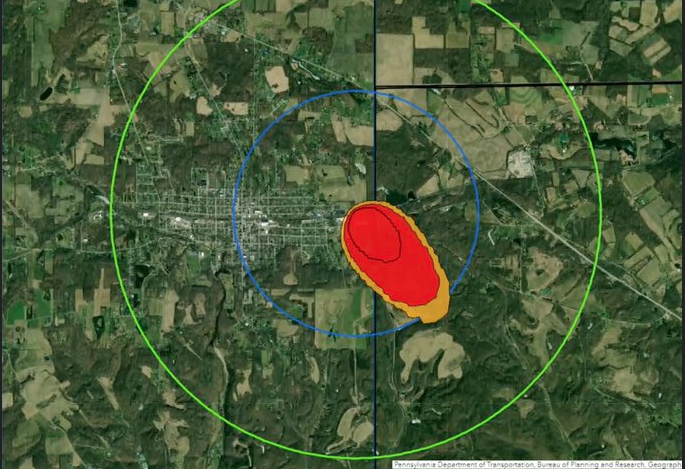Toxic Chemical Residue From Ohio Derailment: Months-Long Contamination

Table of Contents
The Extent of the Contamination
Initial Spill and Immediate Effects
The February 3rd derailment released a cocktail of hazardous materials, most notably vinyl chloride, a known carcinogen. The immediate impact was catastrophic. A controlled burn of the vinyl chloride released toxic fumes into the air, leading to immediate evacuations of East Palestine and surrounding areas.
- Specific chemicals released: Vinyl chloride, butyl acrylate, ethylhexyl acrylate, and ethylene glycol monobutyl ether.
- Immediate air and water contamination levels: Initial air monitoring detected elevated levels of toxic chemicals. Water contamination was also immediately evident, with reports of contaminated waterways.
- Initial evacuation orders: Thousands were evacuated from their homes due to the immediate threat posed by the released chemicals.
- Immediate health concerns reported: Residents reported experiencing headaches, nausea, respiratory issues, and eye irritation.
Long-Term Environmental Impact
The concern extends far beyond the immediate aftermath. The long-term environmental impact of the Ohio train derailment remains a significant threat. The persistence of these chemicals in the soil and water presents a serious risk of long-term contamination.
- Persistence of chemicals in the environment: Vinyl chloride and other chemicals can persist in the environment for extended periods, leaching into groundwater and potentially contaminating drinking water supplies for years to come.
- Potential for groundwater contamination: The proximity of the derailment site to water sources raises serious concerns about the contamination of groundwater, impacting local wells and potentially the broader water supply.
- Impact on wildlife and ecosystems: The released chemicals pose a significant threat to wildlife, impacting local flora and fauna. Long-term studies are needed to fully assess the ecological damage.
- Ongoing monitoring efforts: While monitoring efforts are underway, the long-term nature of the contamination requires continuous vigilance and comprehensive testing.
Contamination Beyond East Palestine
The potential spread of contamination extends beyond East Palestine. The Ohio River and other waterways present pathways for the transport of contaminated materials downstream, while air currents could have dispersed chemicals over a wider geographic area.
- Analysis of water and air samples downwind and downstream: Ongoing testing is crucial to assess the extent of contamination in surrounding areas. Results so far have been varied and raise further concerns.
- Potential impact on neighboring communities: Downstream communities along the Ohio River and other affected waterways are at risk of secondary contamination.
- Transportation of contaminated materials: The potential for the accidental transport of contaminated soil or water through various means requires careful monitoring.
Health Concerns and Long-Term Effects
Immediate Health Impacts
The immediate aftermath saw a surge in reports of various health problems among residents. The symptoms align with the known toxic effects of the released chemicals.
- Specific symptoms reported: Headaches, nausea, vomiting, respiratory problems (coughing, shortness of breath), skin rashes and irritation, and eye irritation were commonly reported.
- Number of individuals affected: The precise number of individuals affected is difficult to ascertain, but reports indicate a substantial number of people sought medical attention.
- Medical assistance provided: Local hospitals and medical facilities provided immediate medical assistance to those affected. However, the long-term effects remain largely unknown.
Potential Long-Term Health Risks
Exposure to vinyl chloride and other released chemicals carries the potential for serious long-term health consequences. The long-term effects of such exposure are a major area of concern.
- Known health effects of vinyl chloride and other released chemicals: Vinyl chloride is a known human carcinogen, linked to liver cancer, brain cancer, and other severe health problems. The long-term effects of other chemicals released remain under investigation.
- Ongoing research into long-term impacts: Extensive research is needed to determine the full extent of the long-term health consequences for exposed individuals.
- Need for long-term health monitoring: A comprehensive, long-term health monitoring program is essential to track the health of residents and assess the potential long-term effects.
Lack of Transparency and Access to Information
Concerns remain regarding the transparency and communication surrounding the health effects of the derailment. Many residents feel that information has been withheld or inadequately communicated.
- Criticisms of the government response: Many have criticized the initial response to the incident and ongoing communication.
- Lack of readily available information: Accessing clear and reliable information regarding the health risks has been challenging for affected residents.
- Challenges faced by residents in accessing healthcare and information: Many residents expressed difficulty in getting timely access to necessary healthcare and information.
Cleanup Efforts and Government Response
Initial Response and Challenges
The initial response to the derailment faced numerous challenges. Containing the spill and initiating effective cleanup proved difficult given the nature and volume of the released chemicals.
- Effectiveness of initial containment efforts: The initial efforts to contain the spill were hampered by the rapid spread of chemicals.
- Criticisms of the response time: There have been criticisms of the response time and the initial handling of the situation.
- Logistical challenges in cleanup: The cleanup operation is complex, costly, and faces significant logistical hurdles.
Ongoing Cleanup and Remediation
Ongoing cleanup efforts are underway, focusing on remediating the contaminated land and water sources. However, the long-term success of these efforts remains uncertain.
- Specific cleanup methods employed: Various methods are being used, including soil removal, water treatment, and air filtration.
- Challenges in removing persistent chemicals: The persistence of some chemicals makes complete removal challenging.
- Long-term monitoring plans: Long-term monitoring is crucial to assess the effectiveness of the cleanup and ensure the safety of the environment.
Accountability and Legal Ramifications
The derailment has led to numerous lawsuits against Norfolk Southern, the railway company responsible for the train. Investigations are underway to determine the cause of the derailment and potential legal liabilities.
- Lawsuits filed against Norfolk Southern: Numerous lawsuits have been filed by residents and businesses seeking compensation for damages.
- Ongoing investigations into the cause of the derailment: Investigations are underway to determine the factors that contributed to the derailment.
- Potential penalties and fines: Norfolk Southern faces potential penalties and fines for its role in the incident.
Conclusion
The Ohio train derailment and the resulting toxic chemical residue represent a significant environmental and public health crisis with long-lasting ramifications. The months-long contamination underscores the urgent need for improved regulations, stricter safety measures, and transparent communication surrounding hazardous material transportation and spill response. Continued monitoring, comprehensive cleanup efforts, and long-term health assessments are crucial to mitigating the lasting impacts of this devastating event. We must learn from the East Palestine tragedy to prevent future incidents involving toxic chemical residue and ensure the safety and well-being of our communities. Understanding the ongoing impact of the Ohio train derailment and its toxic chemical residue is paramount for protecting our environment and public health. Demand accountability and advocate for improved safety regulations concerning hazardous materials transportation.

Featured Posts
-
 Jessica Simpson The Pressure Of Competing With Britney And Christina
May 12, 2025
Jessica Simpson The Pressure Of Competing With Britney And Christina
May 12, 2025 -
 The Many Mishaps Of Boris Johnson With Animals A Compilation
May 12, 2025
The Many Mishaps Of Boris Johnson With Animals A Compilation
May 12, 2025 -
 Fun In The Air Booking Flights Made Easy And Enjoyable
May 12, 2025
Fun In The Air Booking Flights Made Easy And Enjoyable
May 12, 2025 -
 Shop The Latest 2025 New York Yankees Apparel A Buyers Guide
May 12, 2025
Shop The Latest 2025 New York Yankees Apparel A Buyers Guide
May 12, 2025 -
 Chaos Erupts As Crowd Intervenes In Ice Arrest Cnn News
May 12, 2025
Chaos Erupts As Crowd Intervenes In Ice Arrest Cnn News
May 12, 2025
Latest Posts
-
 Schoduvel In Braunschweig Alle Infos Zum Karneval 2025 Im Fernsehen Und Online
May 13, 2025
Schoduvel In Braunschweig Alle Infos Zum Karneval 2025 Im Fernsehen Und Online
May 13, 2025 -
 Der Braunschweiger Karnevalsumzug Schoduvel Ein Voller Erfolg
May 13, 2025
Der Braunschweiger Karnevalsumzug Schoduvel Ein Voller Erfolg
May 13, 2025 -
 Wo Sehe Ich Den Braunschweiger Schoduvel 2025 Im Tv Und Livestream
May 13, 2025
Wo Sehe Ich Den Braunschweiger Schoduvel 2025 Im Tv Und Livestream
May 13, 2025 -
 Braunschweiger Schoduvel Highlights Und Bilder Vom Karnevalsumzug
May 13, 2025
Braunschweiger Schoduvel Highlights Und Bilder Vom Karnevalsumzug
May 13, 2025 -
 Schoduvel 2025 Braunschweig Karneval Im Livestream And Tv
May 13, 2025
Schoduvel 2025 Braunschweig Karneval Im Livestream And Tv
May 13, 2025
